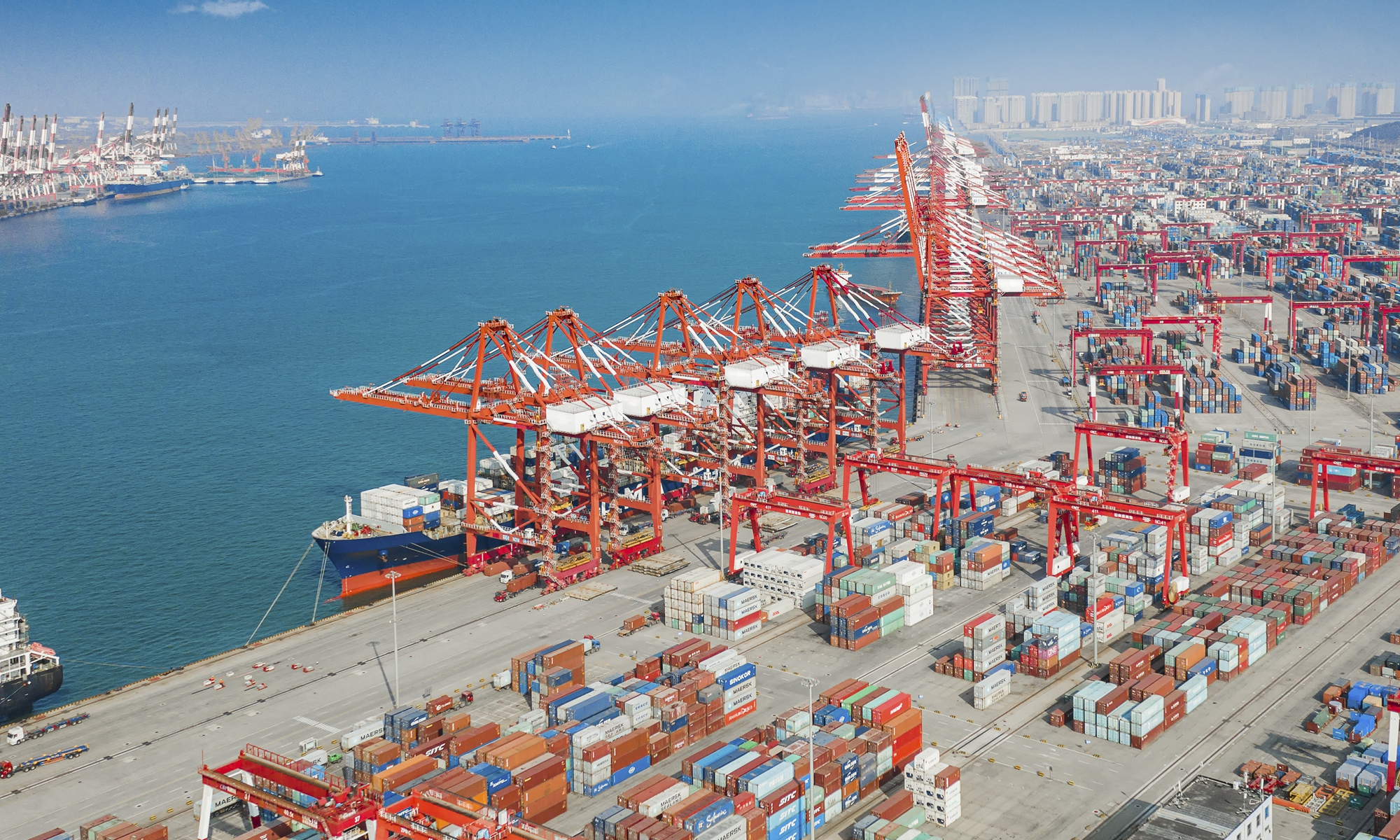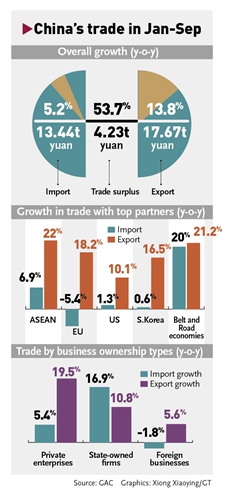
Aerial photo of container cargo terminal of Qianwan port in Qingdao, East China's Shandong Province Photo: IC
China's foreign trade expanded by 8.3 percent year-on-year in yuan terms in September, maintaining a solid growth momentum despite mounting headwinds amid weakening overseas demand due to a looming global recession as well as domestic challenges posed by COVID-19 resurgences.
The resilience of the world's biggest trading nation and second-largest economy will inject a sense of certainty and confidence to the world during this extremely turbulent period, Chinese observers said, while warning about rising pressure in the fourth quarter that could pose more challenges to China's exports.
China's total trade reached 3.81 trillion yuan ($525.4 billion) in September, with exports at 2.19 trillion yuan, an increase of 10.7 percent, and imports rising 5.2 percent, the General Administration of Customs (GAC) said on Monday. The trade surplus stood at 573.57 billion yuan, up 29.9 percent.
In dollar terms, trade went up by 3.4 percent, with imports growing 0.3 percent, unchanged from August, and exports up by 5.7 percent, down from a 7-percent growth in August, according to the GAC.
"Slowing export growth reflects the impact of weakening demand in developed economies such as Europe and the US, while a steady import pace indicates relatively stable domestic demand, supported by government stimulus," Bai Ming, deputy director of the international market research institute at the Chinese Academy of International Trade and Economic Cooperation, told the Global Times on Monday.
"Imports are also constrained by factors such as US sanctions," Bai said.
In general, China's foreign trade situation remains stable in the first nine months of the year, though growth rate sees signs of deceleration since August amid a complex external environment, Bai noted.

In the first three quarters of the year, total trade hit 31.11 trillion yuan, up 9.9 percent from a year earlier. Exports increased 13.8 percent to 17.67 trillion yuan, while imports totaled 13.44 trillion yuan, rising 5.2 percent. The trade surplus reached 4.23 trillion yuan, surging 53.7 percent year-on-year.
In terms of products, exports of mechanical and electrical products totaled 10.04 trillion yuan, up 10 percent, accounting for 56.8 percent of total exports, customs data showed.
Vehicle exports were especially strong, rising 67.1 percent to 259.84 billion yuan, and those of mobile phones, integrated circuits and other electrical appliances maintained high growth.
Tian Yun, former vice director of the Beijing Economic Operation Association, told the Global Times on Monday that China is continuing to upgrade its product structure, and its exports are no longer driven by low-margin products.
The newly released data also reflected that the momentum of upgrading has not been significantly affected by US interest rate hikes or the conflict between Russia and Ukraine, Tian said.
ASEAN remained China's top trading partner in the first nine months, accounting for 15.1 percent of China's total foreign trade.
China's trade with its top three partners - ASEAN, the EU and the US - grew 15.2 percent, 9 percent and 8 percent year-on-year, with total trade of 4.7 trillion yuan, 4.23 trillion yuan and 3.8 trillion yuan.
South Korea was China's fourth-largest trading partner over the period, with bilateral trade up 7.1 percent to 1.81 trillion yuan. Trade with countries along the Belt and Road Initiative jumped 20.7 percent.
Trade with Russia surged by 32.5 percent in the first nine months, with imports from Russia seeing a surge of 51.6 percent.
Observers cautioned that demand from the US and Europe might continue to decline amid recession risks, which will be the biggest challenge for the fourth quarter, and might further weigh on the domestic economy.
Most economists are expecting the US, the world's largest economy might tip into a recession in 2023 or sooner. Gregory Daco, chief economist at EY Parthenon, forecasts a 0.7 percent contraction in growth next year, according to a report from Financial Times.
Meanwhile, the euro zone is also likely to enter a recession with business activity contracting at the fastest pace in nearly two years this month, Reuters reported on Monday.
In contrast, China's economy remains on a stable recovery trajectory. China on Monday reported that its economic performance beat expectations and grew by 3.9 percent year-on-year in the third quarter. In the first three quarters, GDP grew 3 percent to 87 trillion yuan.
China's economy has withstood pressure to achieve continued recovery. The third-quarter economic situation was evidently better than in the second quarter, read a statement by the National Bureau of Statistics on Monday.
Going forward, economists warned of growing risks and challenges for the Chinese economy, including a global economic downturn as well as growing geopolitical disruptions.
"We should be mindful that more countries are putting 'security' ahead of economic development, and we should be prepared," Cao Heping, an economist at Peking University, told the Global Times on Monday.





